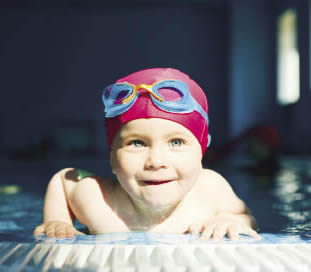
Water Babies
The benefits of raising
water-confident kids
Story by Mara Severin
Sara Morgan doesn’t remember how or when she learned to swim. She just learned. Growing up spending every hot summer day at the town pool made it inevitable. She had early and frequent exposure to clean, temperate and supervised water. In other words, Sara Morgan did not grow up in Alaska.
As an Alaskan mother, Sara came to the realization that her children weren’t just going to “pick up” swimming skills along the way. “You have to be proactive here,” she says. “You have to find and create swimming opportunities for your children.”
It may seem paradoxical that learning to swim in Alaska is such a challenge. With more than 3,000 rivers, 33,000 miles of coastline and three million lakes, Alaska is a very watery state indeed. The water is where many of us work and where most of us play. Boating, fishing, hiking, kayaking, jet-skiing – whatever your family is into, your children are going to get their feet wet – both literally and figuratively.
Early lessons and long rewards
Luckily, the “opportunities” are out there. You just have to seek them out. At Swim Alaska in Wasilla, even the tiniest guppies can learn the ins and outs of the water. “Here we start at six months,” says Tinamarie Buffington, the school’s executive director.
“There’s a lot of research that says swimming is essential for development,” says Tinamarie. “At that early stage, the babies can’t crawl, but in the water they can move their legs as if they’re walking. They have total freedom of movement in the water.”
The benefits of early infant swimming have a lasting effect on your growing child, according to a study from the Norwegian University of Science and Technology. Researcher Hermundur Sigmundsson was fascinated by the results that an infant swimming instructor was able to achieve with his youngest pupils. “The instructor was able to bring 3-month-old babies right up to a balanced position standing on his palm,” says Sigmundsson. “The babies locked joints. It was amazing to watch.”
UNDERSTANDING ALASKA'S WATERS
"Alaska has one of the highest drowning rates in the country," says Joe McCullough, education coordinator with the State Office of Boating Safety. "But it's not because of swimming ability. It's because of Alaska's cold water."
Cold shock leads to hyperventilation and panic which leads to drowning, he says. Therefore no child, regardless of their swimming skills, should ever be near Alaska waters without a personal floatation device. Being a strong swimmer might help your child maintain their calm in an accident and could be the key to their survival, he says, but it does not take the place of proper safety equipment. "In a perfect world, everyone in Alaska would know how to swim," he says, "But that's not enough. Alaska waters kill good swimmers every year."
This led to a study of the dexterity and balance of 4 year olds. Some of whom had swim lessons as infants and some who had not. The swimmers greatly outperformed the non-swimmers.
“It’s incredibly exciting that specific training for young babies has an effect later in life,” he says. “Development is a dynamic interplay between maturation, growth, experience and learning. Our study shows that we must never underestimate the learning aspect.”
Swim like an otter and kick like a frog
Not convinced by the scientific argument? Well here’s another one: Babies in the water are super-duper cute. “They naturally kick their legs like little frogs in the water,” says Tinamarie. “And they have that cute baby fat so they have buoyancy.”
By the age of 4, children are ready for preschool aquatics, says Tinamarie. “We don’t teach strokes,” she says. “We play games and have lots of water fun. We pretend to be aquatic animals – floating on our backs like baby sea otters, floating on our bellies like crocodiles, kicking like frogs.” The idea, she says, is to help children get comfortable and confident in the water.
Swimming in the fast lane and finding your fins
Not all children respond the same way to the water. Some children are instant mermaids and others need more time to find their fins. It’s important not to push your child too hard. Sara’s daughters who took lessons at Swim Like a Fish in Anchorage, learned at very different rates. Donna, age 7, was confidently swimming by the end of her third lesson, while Vanessa, age 5, took considerably longer. “But she enjoyed the lessons anyway,” says Sara, who liked the gentle energy of the instructors and the environment. “They know the difference between being encouraging and being pushy.” Vanessa took little steps toward water independence – blowing bubbles, getting her head wet, holding her breath. “Her comfort level in the water went up right away, even though she wasn’t actually swimming,” says Sara.
Swimming safety
Whatever type of program you choose, water safety should be a major focus. Water awareness is as essential as swimming ability.
“Children need to know how to act around water,” says Tinamarie. “If you don’t know the aquatic environment, you’re more likely to end up in the water by accident.” The majority of people who drown, she says, never intended to be in the water to begin with.
Being taught how to float, breathe and survive during an accidental immersion offers kids a better chance for rescue and survival.
Fitness, safety, physical development, parent-child bonding and just plain fun: What other reasons do you need to help your child find her inner-mermaid or hidden-dolphin?








